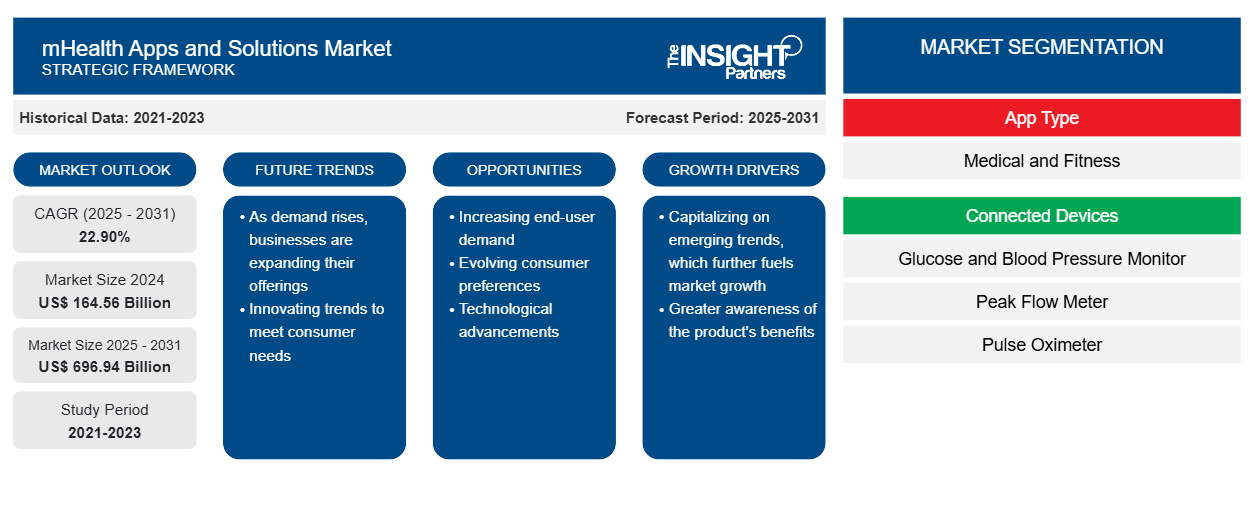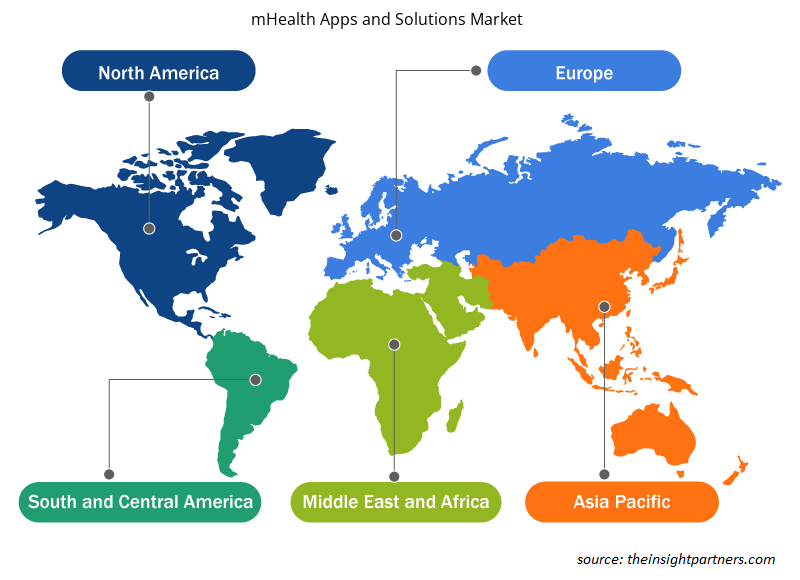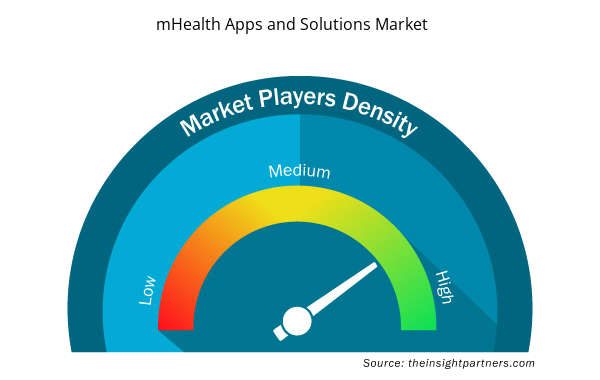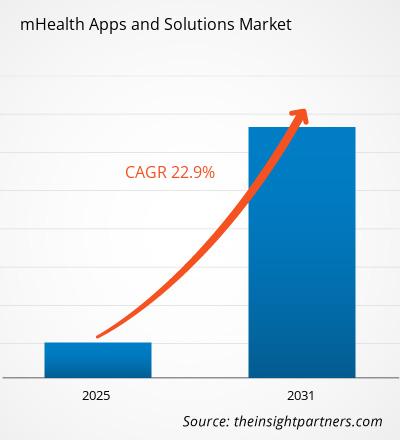[Research Report] The mhealth apps and solutions market size was valued at US$ 108.95 billion in 2022 and is expected to reach US$ 567.89 billion by 2031; it is estimated to register a CAGR of 22.9% from 2022 to 2031.
Market Insights and Analyst View:
mHealth apps and solutions refer to a category of applications and digital tools used to support healthcare, fitness, and medical services through mobile devices such as smartphones, tablets, and wearable devices. These digital solutions bring healthcare information, resources, and services to individuals, caregivers, and healthcare providers, allowing access to health-related data, monitoring, and management virtually from anywhere. Some important components and functionalities of mHealth apps and solutions include health management and monitoring, telemedicine, remote consultation, disease management, fitness and wellness tracking, and behavioral health.
Key factors driving the mhealth apps and solutions market growth include the surge in the use of smart devices for monitoring health and increasing focus on personalized medicine and patient-centered approach. However, issues related to healthcare fraud and data security hinder the market growth.
Growth Drivers and Restraints:
A rise in the adoption of advanced technologies in healthcare is allowing patients, as well as healthcare service providers, to manage personal data and interactions. Smartphones are allowing patients and medical staff to manage hospital consultation schedules and transforming people’s perspectives toward health. Different internet-enabled mobile devices contribute to better management and ease of healthcare practices and data collection. These devices are used to offer services to patients in terms of providing appropriate guidance regarding disease management, guidance, and consultation. Due to the availability of a wide variety of applications with easy access, a large number of people prefer using smartphone apps to avoid waiting times in physician’s offices and get convenient appointments for treatment and diagnostics from virtually anywhere.
In recent years, there has been a surge in the number of individuals suffering from heart disease and diabetes. This has underlined the importance of keeping up physical health among people in developed as well as developing countries. Consequently, the demand for various health monitoring devices has also increased in recent years for keeping track of health parameters. There has been a rise in the number of specialty clinics and home healthcare businesses in countries such as the US, India, and Canada. Asia Pacific holds huge potential for the development of the healthcare sector owing to continuously increasing disposable income and rapid urbanization in leading economies such as Japan, China, and India. Further, the use of handheld and wearable devices for monitoring vital signs has been high among the elderly population as well as millennials. Thus, the surge in the use of smart devices for monitoring health is fueling the mHealth apps and solutions market.
Additionally, In recent years, the patient-centric approach has been predominant in the healthcare industry. Technological innovations and software development are crucial to this healthcare industry revolution. These technological developments support medical and administrative services that dramatically enhance and ease healthcare processes, communications, and workflow. Patient-centric healthcare raises patient satisfaction levels, which creates benefits for healthcare providers and practices. Thus, the rising adoption of a patient-centric approach by healthcare providers is driving the growth of the mhealth apps and solutions market.
However, The protection of sensitive health data recorded by mHealth apps is a major concern among healthcare providers as well as care receivers. The privacy and security concerns associated with remotely monitored medical devices stem from regulatory uncertainties. As technology companies manufacturing medical devices sell personal data to third parties, patients are worried about the privacy of their private data, which may include their biological data. Additionally, if these devices are connected to the medical billing records of the patients, the risk might further entail a financial data breach. According to the HIPAA Journal, 5,150 healthcare data breaches of over 500 records have been reported between 2009 and 2022 to the HHS’ Office for Civil Rights. Those breaches have exposed or impermissibly disclosed 382,262,109 healthcare records. That equates to over 1.2x the population of the US. In 2022, an average of 1.94 data breaches of 500 or more healthcare records were reported daily.
Despite the medical device manufacturers investing increasingly high amounts for enhancing the security of their offerings, consumers are likely to take some time to rely on devices for their healthcare-related activities completely. Thus, issues related to data security and privacy are limiting the adoption of mHealth apps, thereby hindering market growth.
Customize This Report To Suit Your Requirement
You will get customization on any report - free of charge - including parts of this report, or country-level analysis, Excel Data pack, as well as avail great offers and discounts for start-ups & universities
mHealth Apps and Solutions Market: Strategic Insights

- Get Top Key Market Trends of this report.This FREE sample will include data analysis, ranging from market trends to estimates and forecasts.
Customize This Report To Suit Your Requirement
You will get customization on any report - free of charge - including parts of this report, or country-level analysis, Excel Data pack, as well as avail great offers and discounts for start-ups & universities
mHealth Apps and Solutions Market: Strategic Insights

- Get Top Key Market Trends of this report.This FREE sample will include data analysis, ranging from market trends to estimates and forecasts.
Report Segmentation and Scope:
The global mhealth apps and solutions market is categorized on the basis of app type, connected devices, services, end users, and geography. Based on app type, the mhealth apps and solutions market is bifurcated into medical and fitness. Based on connected devices, the mhealth apps and solutions market is divided into glucose and blood pressure monitor, peak flow meter, pulse oximeter, neurological monitors, and others. Based on services, the market is segmented into patient monitoring, wellness management, and consultation. Based on end users, the market is differentiated into physicians, patients, hospitals, and healthcare insurance companies. The mhealth apps and solutions market, based on geography, is segmented into North America (the US, Canada, and Mexico), Europe (Germany, France, Italy, the UK, Russia, and the Rest of Europe), Asia Pacific (Australia, China, Japan, India, South Korea, and the Rest of Asia Pacific), Middle East & Africa (South Africa, Saudi Arabia, the UAE, and the Rest of Middle East & Africa), and South & Central America (Brazil, Argentina, and the Rest of South & Central America).
Segmental Analysis:
The mhealth apps and solutions market, by app type, is bifurcated into medical and fitness. The Medical segment held the largest mhealth apps and solutions market share in 2022, and it is anticipated to register the highest CAGR in the market during 2022-2031.
Based on connected devices, the mhealth apps and solutions market is divided into glucose and blood pressure monitor, peak flow meter, pulse oximeter, neurological monitors, and others. The glucose and blood pressure monitor segment held the largest mhealth apps and solutions market share in 2022, and the same segment is expected to register the highest CAGR in the market during 2022-2031.
Based on services, the market is segmented into patient monitoring, wellness management, and consultation. The patient monitoring segment held the largest mhealth apps and solutions market in 2022. However, the wellness management segment is expected to register the highest CAGR in the market during 2022-2031.
Based on end users, the market is differentiated into physicians, patients, hospitals, and healthcare insurance companies. The patient segment held the largest mhealth apps and solutions market share in 2022. However, the hospital segment is expected to register the highest CAGR in the market during 2022-2031.
Regional Analysis:
Based on geography, the global mhealth apps and solutions market is segmented into five key regions: North America, Europe, Asia Pacific, South & Central America, and Middle East & Africa. Asia Pacific is estimated to register the highest CAGR during 2022–2031, owing to an increasing aging population, rising cancer prevalence, and rising healthcare costs.
The mHealth apps and solutions market in North America is anticipated to witness growth at a significant rate during the forecast period owing to various factors such as a technologically advanced healthcare system, rapid adoption of healthcare IT, and increasing government funding, among others. Also, to enhance patient care and satisfaction, the adoption of mhealth apps is expected to witness tremendous growth in the North American region during the forecast period. Moreover, increasing focus on digitalization in healthcare and reducing traffic for appointments for medical treatments is further expected to stimulate growth and contribute to exceptional revenue generation for the mhealth apps and solutions market in North America.
Industry Developments and Future Opportunities:
Various initiatives taken by key players operating in the global mhealth apps and solutions market are listed below:
- In October 2023, Cedars-Sinai created a new artificial intelligence-driven mHealth application that offers virtual care alternatives for a variety of clinical ailments to patients in California. The Cedars-Sinai Connect app gives virtual access to healthcare professionals for urgent care and same-day appointments for primary care 24 hours a day, seven days a week. Patients can use the app to seek help for a variety of ailments, including colds, headaches, anxiety, type 2 diabetes, wellness visits, and expert referrals.
- In October 2023, MongoDB Inc. announced the launch of MongoDB Atlas for Healthcare and MongoDB Atlas for Insurance, two new initiatives that help companies in these industries accelerate their pace of innovation and better serve end-users with modern, data-driven applications. MongoDB Atlas for Healthcare and MongoDB Atlas for Insurance include expert-led innovation workshops, tailored technology partnerships, and industry-specific knowledge accelerators to provide customized training paths designed for a range of use cases that developers in these industries work with.
- In February 2023, Vodafone collaborated with Charité Berlin (one of Europe’s largest university hospitals), Leipzig University Hospital, and 16 other leading research and medical experts across Germany to explore future medical applications using 6G.
- In January 2023, Garmin Ltd announced the launch of Instinct Crossover & Instinct Crossover Solar in India, the newest and most unique addition to the popular Instinct family of rugged, purpose-built GPS multisport smartwatches. The Instinct Crossover delivers Garmin’s full suite of wellness features, including Sleep Score Advanced Sleep Monitoring and Health Monitoring activities, which allows users to record key health metrics, such as Body Battery, stress, and heart rate, in a single view.
- In January 2023, Royal Philips, a global leader in health technology, partnered with Masimo. The companies announced an expansion of their partnership to augment patient monitoring capabilities in home telehealth applications with the Masimo W1 advanced health tracking watch. The W1 will integrate with Philips’s enterprise patient monitoring ecosystem to advance the forefront of telemonitoring and telehealth.
Competitive Landscape and Key Companies:
Medical Information Technology Inc., Boston Scientific Corporation, Apple Inc., Peerfit Inc., Abbott, ALYKA Health, Koninklijke Philips NV, Teladoc Health Inc, MyFitnessPal Inc, and Fitbit Inc are among the prominent players operating in the mhealth apps and solutions market. These companies focus on new technologies, advancements in existing products, and geographic expansions to meet the growing consumer demand worldwide and increase their product range in specialty portfolios.
Report ScopemHealth Apps and Solutions Market Regional Insights
The regional trends and factors influencing the mHealth Apps and Solutions Market throughout the forecast period have been thoroughly explained by the analysts at Insight Partners. This section also discusses mHealth Apps and Solutions Market segments and geography across North America, Europe, Asia Pacific, Middle East and Africa, and South and Central America.

- Get the Regional Specific Data for mHealth Apps and Solutions Market
mHealth Apps and Solutions Market Report Scope
| Report Attribute | Details |
|---|---|
| Market size in 2024 | US$ 164.56 Billion |
| Market Size by 2031 | US$ 696.94 Billion |
| Global CAGR (2025 - 2031) | 22.90% |
| Historical Data | 2021-2023 |
| Forecast period | 2025-2031 |
| Segments Covered |
By App Type
|
| Regions and Countries Covered | North America
|
| Market leaders and key company profiles |
mHealth Apps and Solutions Market Players Density: Understanding Its Impact on Business Dynamics
The mHealth Apps and Solutions Market market is growing rapidly, driven by increasing end-user demand due to factors such as evolving consumer preferences, technological advancements, and greater awareness of the product's benefits. As demand rises, businesses are expanding their offerings, innovating to meet consumer needs, and capitalizing on emerging trends, which further fuels market growth.
Market players density refers to the distribution of firms or companies operating within a particular market or industry. It indicates how many competitors (market players) are present in a given market space relative to its size or total market value.
Major Companies operating in the mHealth Apps and Solutions Market are:
- Medical Information Technology Inc.
- Boston Scientific Corporation
- Apple Inc.
- Peerfit Inc.
- Abbott
Disclaimer: The companies listed above are not ranked in any particular order.

- Get the mHealth Apps and Solutions Market top key players overview
- Historical Analysis (2 Years), Base Year, Forecast (7 Years) with CAGR
- PEST and SWOT Analysis
- Market Size Value / Volume - Global, Regional, Country
- Industry and Competitive Landscape
- Excel Dataset


- Virtual Pipeline Systems Market
- Dry Eye Products Market
- Quantitative Structure-Activity Relationship (QSAR) Market
- Smart Water Metering Market
- USB Device Market
- Embolization Devices Market
- Advanced Planning and Scheduling Software Market
- Clear Aligners Market
- Sexual Wellness Market
- Architecture Software Market

Report Coverage
Revenue forecast, Company Analysis, Industry landscape, Growth factors, and Trends

Segment Covered
This text is related
to segments covered.

Regional Scope
North America, Europe, Asia Pacific, Middle East & Africa, South & Central America

Country Scope
This text is related
to country scope.
Trends and growth analysis reports related to Technology, Media and Telecommunications : READ MORE..
- Medical Information Technology Inc.
- Boston Scientific Corporation
- Apple Inc.
- Peerfit Inc.
- Abbott
- ALYKA Health
- Koninklijke Philips NV
- Teladoc Health Inc
- MyFitnessPal Inc
- Fitbit Inc

 Get Free Sample For
Get Free Sample For